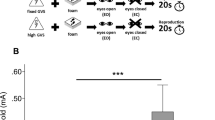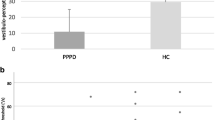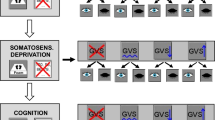Abstract
Purpose
To assess whether vestibulo-ocular reflex (VOR) gain, posturography parameters and related clinical outcomes can improve in OSA patients after 12 months of CPAP treatment, taking into consideration that a certain degree of vestibular dysfunction has been identified in these subjects.
Methods
Vestibular, postural, clinical, and polygraphic parameters were assessed in 32 OSA patients before and after beneficial CPAP treatment by means of video head impulse test (vHIT), static posturography (SP), Dizziness Handicap Inventory (DHI), Epworth Sleepiness Scale (ESS), and Apnea–Hypopnea Index (AHI), respectively, and were compared by means of a “within-subject” ANOVA model and Spearman’s rank correlation.
Results
After the 12-month period of treatment, OSA patients demonstrated a significant reduction in AHI values, in both opened and closed eyes conditions of surface and length as well as in power spectra recorded in low, middle, and high frequency interval. Although a significant improvement was also recorded among DHI and ESS scores, VOR gain increase did not survive to post-hoc corrections. Finally, positive correlations between the differences between pre- and post-treatment AHI, ESS, and PS values were found.
Conclusions
The present work highlighted that postural instability and dizziness-related conditions due to OSA may improve after 12 months of CPAP treatment. Although VOR gain did not demonstrate significant improvement, this study might open future perspectives directed to assessing VOR gain changes after longer periods of CPAP treatment.



Similar content being viewed by others
Abbreviations
- AHI:
-
Apnea–Hypopnea Index
- ODI:
-
Oxygen desaturation index
- SaO2 :
-
Oxygen saturation
- lowest SaO2 :
-
Time spent with SaO2 < 90%
- vHIT:
-
Video Head Impulse Testing
- SPT:
-
Static Posturography Testing
- SP:
-
Stiff platform
- FC:
-
Foam carpet
- FFT:
-
Fast Fourier transform
- PS:
-
Power spectra of body oscillations
- DHI:
-
Italian Dizziness Handicap Inventory
- ESS:
-
Epworth Sleepiness Scale
- VOR:
-
Vestibulo-ocular reflex
References
Kayabasi S, Iriz A, Cayonu M, Cengiz B, Acar A, Boynuegri S, Mujdeci B, Eryilmaz A (2015) Vestibular functions were found to be impaired in patients with moderate-to-severe obstructive sleep apnea. Laryngoscope 125(5):1244–1248. https://doi.org/10.1002/lary.25021
Archbold KH, Borghesani PR, Mahurin RK, Kapur VK, Landis CA (2009) Neural activation patterns during working memory tasks and OSA disease severity: preliminary findings. J Clin Sleep Med 5(1):21–27
Nashner LM (1985) Strategies for organization of human posture. In: Igarashi M, Black FO (eds) Vestibular and Visual Control on Posture and Locomotor Equilibrium. Karger, Basel, pp 1–8. https://doi.org/10.1159/000410293
Bougard C, Davenne D (2014) Morning/evening differences in somatosensory inputs for postural control. Biomed Res Int 2014:287436. https://doi.org/10.1155/2014/287436
Morad Y, Azaria B, Avni I, Barkana Y, Zadok D, Kohen-Raz R, Barenboim E (2007) Posturography as an indicator of fatigue due to sleep deprivation. Aviat Space Environ Med 78(9):859–863
Drummond SP, Brown GG (2001) The effects of total sleep deprivation on cerebral responses to cognitive performance. Neuropsychopharmacology 25(5 Suppl):S68–S73. https://doi.org/10.1016/s0893-133x(01)00325-6
Quarck G, Ventre J, Etard O, Denise P (2006) Total sleep deprivation can increase vestibulo-ocular responses. J Sleep Res 15(4):369–375. https://doi.org/10.1111/j.1365-2869.2006.00550.x
Bougard C, Lepelley MC, Davenne D (2011) The influences of time-of-day and sleep deprivation on postural control. Exp Brain Res 209(1):109–115. https://doi.org/10.1007/s00221-010-2524-8
Fabbri M, Martoni M, Esposito MJ, Brighetti G, Natale V (2006) Postural control after a night without sleep. Neuropsychologia 44(12):2520–2525. https://doi.org/10.1016/j.neuropsychologia.2006.03.033
Gomez S, Patel M, Berg S, Magnusson M, Johansson R, Fransson PA (2008) Effects of proprioceptive vibratory stimulation on body movement at 24 and 36h of sleep deprivation. Clin Neurophysiol 119(3):617–625. https://doi.org/10.1016/j.clinph.2007.10.058
Gallina S, Dispenza F, Kulamarva G, Riggio F, Speciale R (2010) Obstructive sleep apnoea syndrome (OSAS): effects on the vestibular system. Acta Otorhinolaryngol Ital 30(6):281–284
Mutlu M, Bayir O, Yuceege MB, Karagoz T, Firat H, Ozdek A, Akin I, Korkmaz H (2015) Vestibular evoked myogenic potential responses in obstructive sleep apnea syndrome. Eur Arch Otorhinolaryngol 272(11):3137–3141. https://doi.org/10.1007/s00405-014-3294-x
Micarelli A, Liguori C, Viziano A, Izzi F, Placidi F, Alessandrini M (2017) Integrating postural and vestibular dimensions to depict impairment in moderate-to-severe obstructive sleep apnea syndrome patients. J Sleep Res 26(4):487–494. https://doi.org/10.1111/jsr.12516
Henderson LA, Fatouleh RH, Lundblad LC, McKenzie DK, Macefield VG (2016) Effects of 12 months continuous positive airway pressure on sympathetic activity related brainstem function and structure in obstructive sleep apnea. Front Neurosci 10:90. https://doi.org/10.3389/fnins.2016.00090
Lundblad LC, Fatouleh RH, McKenzie DK, Macefield VG, Henderson LA (2015) Brain stem activity changes associated with restored sympathetic drive following CPAP treatment in OSA subjects: a longitudinal investigation. J Neurophysiol 114(2):893–901. https://doi.org/10.1152/jn.00092.2015
Diamanti C, Manali E, Ginieri-Coccossis M, Vougas K, Cholidou K, Markozannes E, Bakakos P, Liappas I, Alchanatis M (2013) Depression, physical activity, energy consumption, and quality of life in OSA patients before and after CPAP treatment. Sleep Breath 17(4):1159–1168. https://doi.org/10.1007/s11325-013-0815-6
Fekete K, Boutou AK, Pitsiou G, Chavouzis N, Pataka A, Athanasiou I, Ilonidis G, Kontakiotis T, Argyropoulou P, Kioumis I (2016) Resting energy expenditure in OSAS: the impact of a single CPAP application. Sleep Breath 20(1):121–128. https://doi.org/10.1007/s11325-015-1194-y
Berry RB, Budhiraja R, Gottlieb DJ, Gozal D, Iber C, Kapur VK, Marcus CL, Mehra R, Parthasarathy S, Quan SF, Redline S, Strohl KP, Davidson Ward SL, Tangredi MM (2012) Rules for scoring respiratory events in sleep: update of the 2007 AASM manual for the scoring of sleep and associated events. Deliberations of the sleep apnea definitions task force of the American Academy of sleep medicine. J Clin Sleep Med 8(5):597–619. https://doi.org/10.5664/jcsm.2172
Liguori C, Placidi F, Palmieri MG, Izzi F, Ludovisi R, Mercuri NB, Pierantozzi M (2018) Continuous positive airway pressure treatment may improve optic nerve function in obstructive sleep apnea: an electrophysiological study. J Clin Sleep Med 14(6):953–958. https://doi.org/10.5664/jcsm.7158
Micarelli A, Viziano A, Bruno E, Micarelli E, Alessandrini M (2016) Vestibular impairment in multiple chemical sensitivity: component analysis findings. J Vestib Res 26(5–6):459–468. https://doi.org/10.3233/ves-160594
Liguori C, Izzi F, Mercuri NB, Romigi A, Cordella A, Tarantino U, Placidi F (2017) Vitamin D status of male OSAS patients improved after long-term CPAP treatment mainly in obese subjects. Sleep Med 29:81–85. https://doi.org/10.1016/j.sleep.2016.08.022
Moon M, Chang SO, Kim MB (2017) Diverse clinical and laboratory manifestations of bilateral vestibulopathy. Laryngoscope 127(1):E42–e49. https://doi.org/10.1002/lary.25946
Alessandrini M, D’Erme G, Bruno E, Napolitano B, Magrini A (2003) Vestibular compensation: analysis of postural re-arrangement as a control index for unilateral vestibular deficit. Neuroreport 14(7):1075–1079. https://doi.org/10.1097/01.wnr.0000070827.57864.49
Bruno E, De Padova A, Napolitano B, Marroni P, Batelli R, Ottaviani F, Alessandrini M (2009) Voice disorders and posturography: variables to define the success of rehabilitative treatment. J Voice 23(1):71–75. https://doi.org/10.1016/j.jvoice.2007.06.002
Nola G, Mostardini C, Salvi C, Ercolani AP, Ralli G (2010) Validity of Italian adaptation of the Dizziness Handicap Inventory (DHI) and evaluation of the quality of life in patients with acute dizziness. Acta Otorhinolaryngol Ital 30(4):190
Johns MW (1991) A new method for measuring daytime sleepiness: the Epworth sleepiness scale. Sleep 14(6):540–545
Vignatelli L, Plazzi G, Barbato A, Ferini-Strambi L, Manni R, Pompei F, D'Alessandro R (2003) Italian version of the Epworth sleepiness scale: external validity. Neurol Sci 23(6):295–300. https://doi.org/10.1007/s100720300004
Yoneda S, Tokumasu K (1986) Frequency analysis of body sway in the upright posture. Statistical study in cases of peripheral vestibular disease. Acta Otolaryngol 102(1–2):87–92
Micarelli A, Viziano A, Augimeri I, Micarelli D, Alessandrini M (2017) Three-dimensional head-mounted gaming task procedure maximizes effects of vestibular rehabilitation in unilateral vestibular hypofunction: a randomized controlled pilot trial. Int J Rehabil Res 40:325–332. https://doi.org/10.1097/mrr.0000000000000244
Kohen-Raz R, Himmelfarb M, Tzur S, Kohen-Raz A, Shub Y (1996) An initial evaluation of work fatigue and circadian changes as assessed by multiplate posturography. Percept Mot Skills 82(2):547–557. https://doi.org/10.2466/pms.1996.82.2.547
Huynh NT, Prilipko O, Kushida CA, Guilleminault C (2014) Volumetric brain morphometry changes in patients with obstructive sleep apnea syndrome: effects of CPAP treatment and literature review. Front Neurol 5:58. https://doi.org/10.3389/fneur.2014.00058
Wu JC, Gillin JC, Buchsbaum MS, Hershey T, Hazlett E, Sicotte N, Bunney WE Jr (1991) The effect of sleep deprivation on cerebral glucose metabolic rate in normal humans assessed with positron emission tomography. Sleep 14(2):155–162
Cao MT, Sternbach JM, Guilleminault C (2017) Continuous positive airway pressure therapy in obstuctive sleep apnea: benefits and alternatives. Expert Rev Respir Med 11(4):259–272. https://doi.org/10.1080/17476348.2017.1305893
Author information
Authors and Affiliations
Contributions
MA, AM, CL, and AV conceived and designed the experiment; AM, MA, AV, FP, FI, CL, and AL performed the experiment; AM, MA, CL, AV, and NBM analyzed the data; MA, FI, AM, CL, FP, DC, AL, and NBM contributed clinical data/materials/analysis tools; AM, MA, CL, and AV wrote the paper.
Corresponding author
Ethics declarations
Conflict of interest
The authors declare that they have no conflict of interest.
Ethical approval
All procedures performed in studies involving human participants were in accordance with the ethical standards of the institutional and/or national research committee and with the 1964 Helsinki declaration and its later amendments or comparable ethical standards.
Informed consent
Informed consent was obtained from all individual participants included in the study.
Rights and permissions
About this article
Cite this article
Alessandrini, M., Liguori, C., Viziano, A. et al. Postural and vestibular changes related to CPAP treatment in moderate-to-severe OSA patients: a 12-month longitudinal study. Sleep Breath 23, 665–672 (2019). https://doi.org/10.1007/s11325-018-1754-z
Received:
Revised:
Accepted:
Published:
Issue Date:
DOI: https://doi.org/10.1007/s11325-018-1754-z




